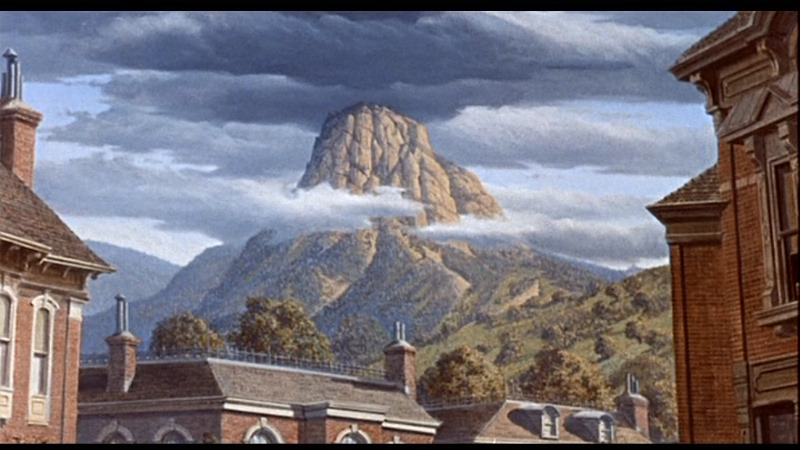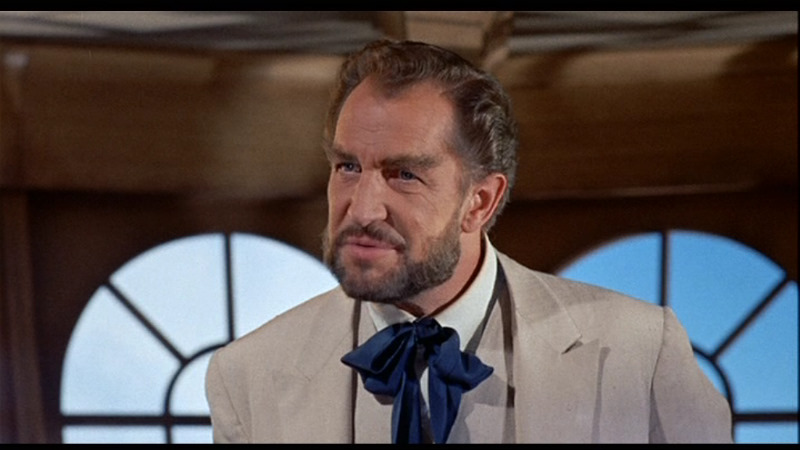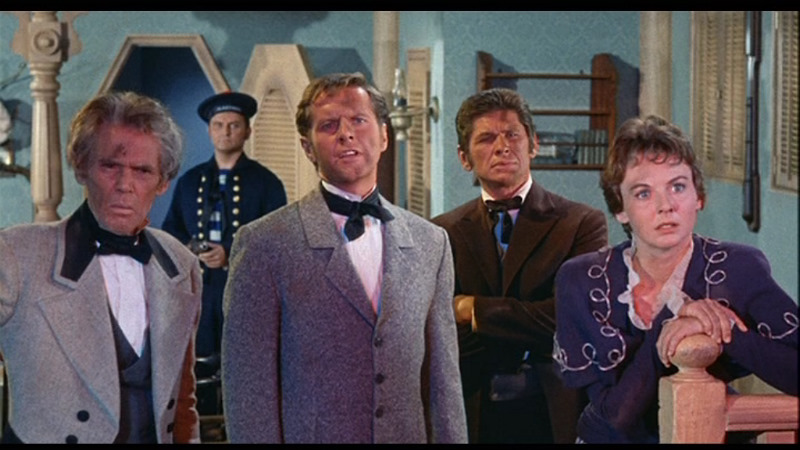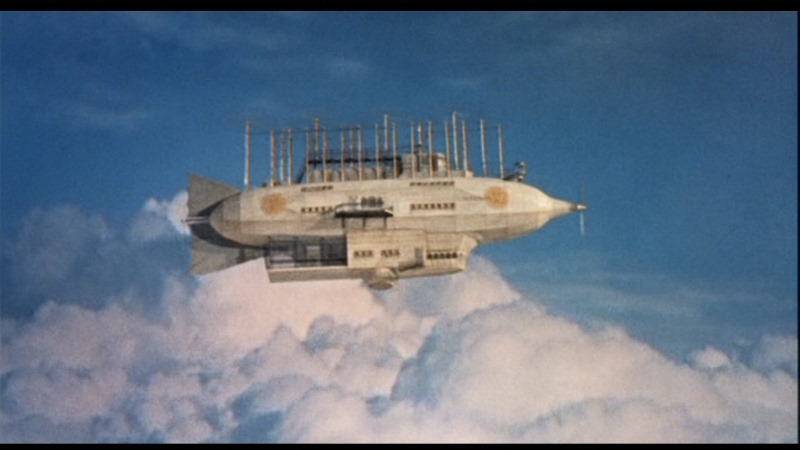Vincent Price And Cast Fly Over Stock Footage In Fun AIP-produced Jules Verne Epic.
DIRECTED BY WILLIAM WITNEY
BLU-RAY STREET DATE: AUGUST 31, 2021/KINO LORBER

James H. Nicholson and Samuel Z. Arkoff present American International Pictures’ high-flying production of Jules Verne’s Master of the World, starring Vincent Price and Charles Bronson.
Explaining, or perhaps deflating, the airborne bombast of the broad description above would require a mini-history in and of itself, but here are the broad strokes: AIP had recently come off the runaway success of Roger Corman’s House of Usher (1960), starring Vincent Price in the first of an eventual seven films based on or inspired by the works of Edgar Allan Poe, and were themselves inspired to reach beyond the company’s humble stock-and-trade the past half-decade of youth-oriented leather jackets-and-chains hot rod flicks and rubber-suited monsters terrorizing day-for-night-shot beaches. Looking skyward to the aerial works of French fabulist Jules Verne, AIP producers Nicholson and Arkoff recruited Usher screenwriter Richard Matheson to adapt one of Verne’s imaginary travelogues for Usher star Vincent Price. With typical AIP economy, Matheson supplied a screenplay based on not one but two Verne epics, Robur the Conqueror (1886) and Master of the World (1904), both featuring the megalomaniacal air pirate Robur.
Produced at a tenth of the budgets for their main Verne sources of previous movie inspiration, Disney’s 20,000 Leagues Under the Sea (1954) and Mike Todd’s Around the World in 80 Days (1956), Master of the World was not quite the epic Nicholson and Arkoff envisioned, or the high-minded adaptation written — Matheson adding complex elements of anti-war terrorism to the source materials — but, despite mismatched stock footage, poor model work, and slapdash editing, the intended roadshow production is kept mainly in flight due to the strength of its cast, assured direction, and colorful stylistics. Admittedly, however, tolerance for the former may largely depend on an individual viewer’s critical embrace of the latter.

Preceded by an easily excised but spottily amusing prologue detailing the early history of flight (a silent movie parody showing footage of crashing airplanes), the film proper proceeds post-opening credits, but backwards in time, to post-Civil War Morgantown, Pennsylvania, where a looming matte-painted volcano spouts both a seismic flow of underground rumblings and an unmistakable, echoing voice intoning a wrathful Bible verse. A plenipotentiary arms manufacturer (Henry Hull), his spirited daughter (Mary Webster), a balloonist business rival to the father and romantic hopeful to the daughter (David Frankham), and finally a federal geologist (Charles Bronson) are dispatched from a contentious meeting of aerialists to investigate the mysterious phenomenon. Sky-approaching the area of disturbance, the balloonist’s low-flying craft is shot down by a volley of rockets coming from the mouth of the volcano, and the quartet of survivors are promptly picked up by the source of the underground rumblings, the airship Albatross, and its deep-voiced captain, known only as Robur (Vincent Price).


Sky prisoners for the next hour-and-twenty minutes of film flying-time, the unwilling Albatross passengers are introduced to the marvels of aerial travel by Robur and his astonishing zeppelin-cum-ship liner, even as the air captain’s grand project of strategic bombings throughout the world become disturbingly and destructively clear. Led by the capable geologist, who is also soon attracted to the equally strong industrialist’s daughter, and who just as quickly makes a bitter rival of the former balloonist, the tense captives plot to disrupt Robur’s plan of forced global disarmament by blowing up the mighty Albatross.

Best viewed, perhaps, in a Saturday afternoon frame of mind, the boy’s adventure aspect of AIP’s Master of the World successfully captures at least something of Jules Verne’s own literary project of the Impossible Vacation, whether under the sea, to the moon, or in the center of the earth. Here, it’s hovering over the world, and although Robur’s second air adventure was published just a few months after the first successful flight by the Wright brothers in late 1903, and the next half-century of both air-flight and air-war would in fact exceed the pioneering science fiction writer’s vision, the film nevertheless has enough extra-terrestrial wonder to remain aloft over spatially, geographically, and even historically confusing sixteenth-century London (taken from the prologue to Laurence Olivier’s Henry V [1944]), a Napoleonic naval battle (plucked from blue-tinted black-and-white footage of That Hamilton Woman [1945]), and the Mahdi uprising of turn-of-the-century India (captured from 1938’s The Four Feathers).
Above all, what succeeds is Vincent Price’s total commitment to his characterization, exhibiting the lofty yet destructive ideals and utter ruthlessness yet humanizing empathy of his madman genius. It’s been said that the most dangerous of monsters is the highly-principled one, and Price portrays his Robur as a compellingly multi-faceted Master of the World. Rounded out by a flavorful cast, including the equally masterful Henry Hull and game supporting leads David Frankham and Mary Webster; even Charles Bronson brings something of the real Pennsylvania coal mines to his convincingly cultured geologist, and ultimately proves a worthy and refreshingly earthy adversary to Price’s considerably less-grounded Robur.
Also waging worthy battle against Messrs. Nicholson and Arkoff’s tight budget-strings is veteran action director William Witney, who in addition to his colorful Westerns of the 1940’s and 50’s starring Roy Rogers, many of which coincidentally had been shot on the then former Republic Studios lot, had preceded that work with numerous project-appropriate adventure serials like Daredevils of the Red Circle (1939). The color and energy of a camera wheeling down a bright, primary-lit aerial hallway, or Robur spectacularly air-hauling combative and recalcitrant Bronson and Frankham, or just gleefully showing off the rising numbers on the ship’s “heightometer”, as the air whines and whistles past the parallel panes of Robur’s expansive, 360-degree cockpit, go a long way towards making this fantastic voyage vivid and even exciting.
But, well, one is encouraged to judge for oneself. Aiding that judgment is Kino Lorber’s slipcover special edition Blu-ray, which comes with a new commentary featuring Tom Weaver and Lucy Chase Williams, an older commentary featuring then 89-year-old cast member David Frankham, and an hour-plus documentary titled Richard Matheson, Storyteller, featuring career-reflective interviews with the late influential writer conducted in 2001. The Weaver commentary is the most informative, with interview sound-bites, cast and filmmaker actor-reenactments, and a multiplicity of views on the background, strengths, and drawbacks of the film. The Frankham commentary is quite charming, with the elderly, British-born actor reminiscing on his long friendship with frequent co-star Vincent Price, and his strong memories of the film (which, equally charming, are in fact very fond). Oddly connecting the latter to the Richard Matheson documentary is the somewhat crusty and no-nonsense writer praising Frankham’s somewhat thankless role in the movie over its “miscast” second lead, Charles Bronson, the changes to his script made by its director, and, to his mind, the overall production’s insuperable budgetary compromises.
Visually, Master of the World appears to great advantage in high definition, and even manages to balance some of the thundering effects of Les Baxter’s bombastic score. (Possibly, in post-production, the sound-editor felt he could somehow drown out the film’s visual shortcomings by simply turning up the music.) Jules Verne has received many more impressive and effective translations to the screen, perhaps, but Kino Lorber’s presentation of Master of the World might very well make an effective argument to AIP, William Witney, and Vincent Price and cast’s being among the most fun.
Images, credited to DVDBeaver, are used only as a visual reference to the film and are not reflective of the image quality of Kino Lorber’s Blu-ray.

